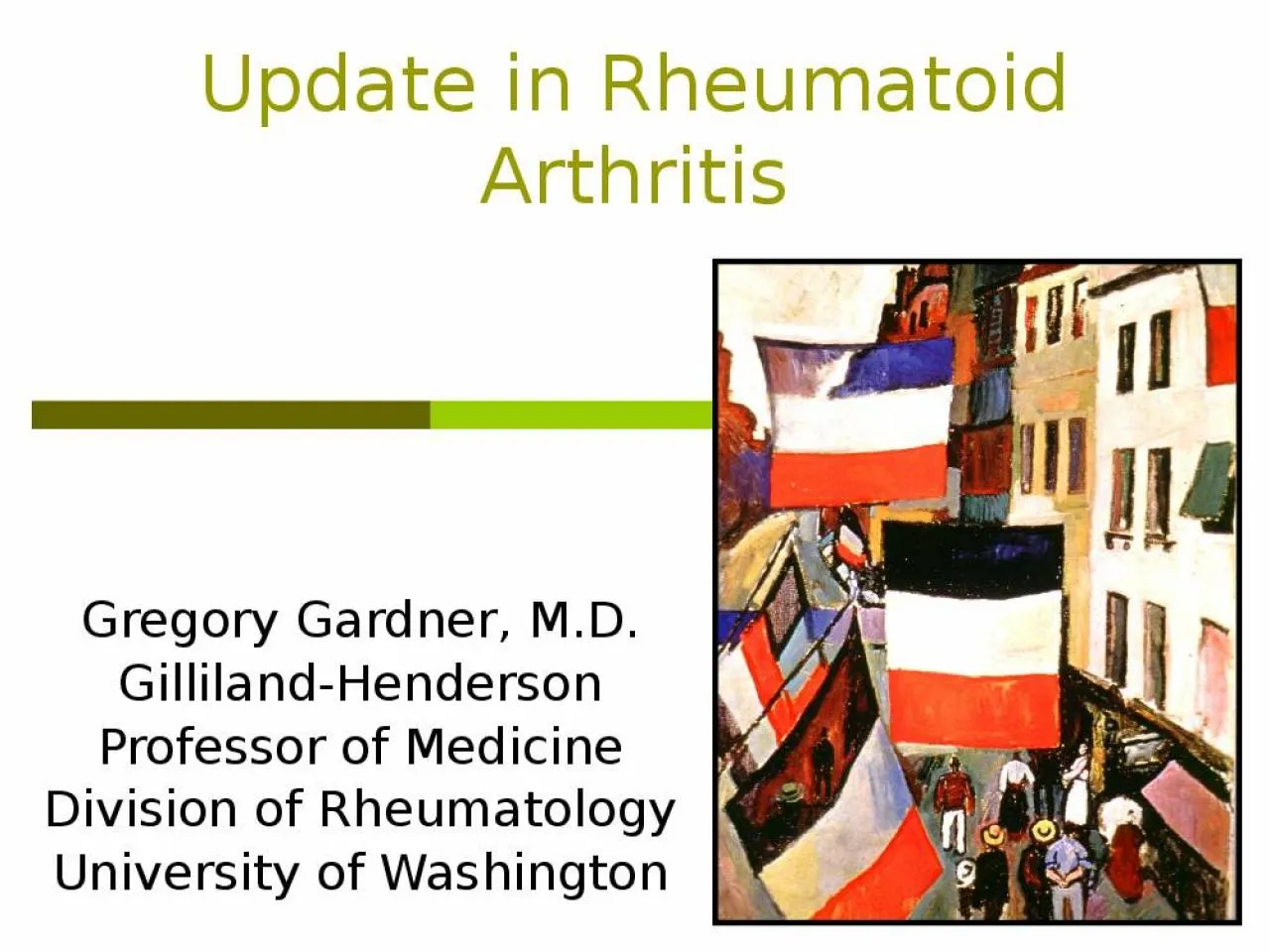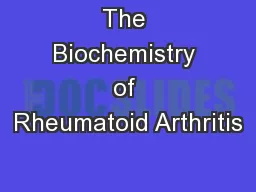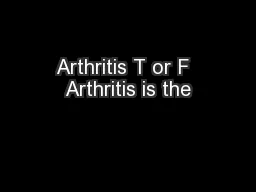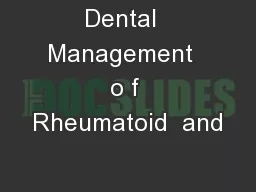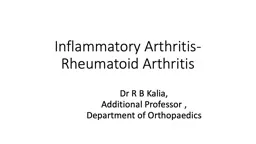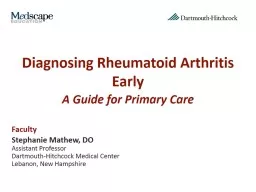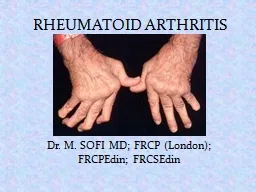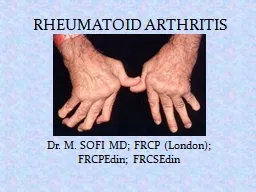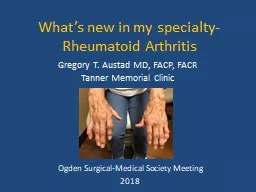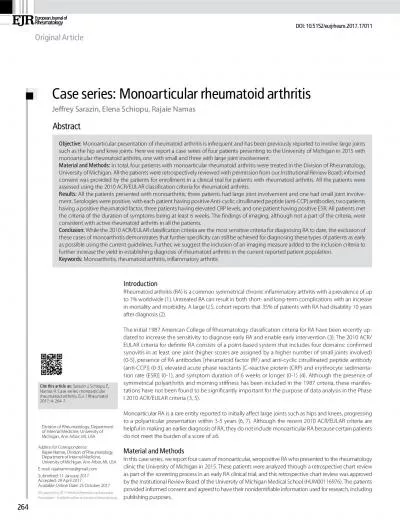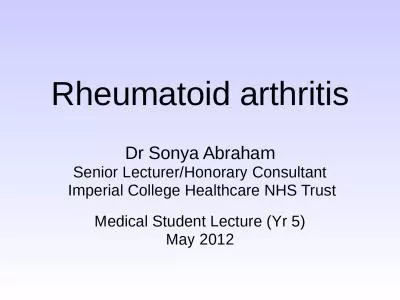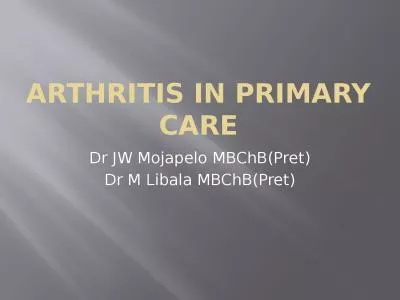PPT-Update in Rheumatoid Arthritis
Author : tracy | Published Date : 2022-02-15
Gregory Gardner MD GillilandHenderson Professor of Medicine Division of Rheumatology University of Washington Outline of Discussion Pathophysiology Clinical Features
Presentation Embed Code
Download Presentation
Download Presentation The PPT/PDF document "Update in Rheumatoid Arthritis" is the property of its rightful owner. Permission is granted to download and print the materials on this website for personal, non-commercial use only, and to display it on your personal computer provided you do not modify the materials and that you retain all copyright notices contained in the materials. By downloading content from our website, you accept the terms of this agreement.
Update in Rheumatoid Arthritis: Transcript
Gregory Gardner MD GillilandHenderson Professor of Medicine Division of Rheumatology University of Washington Outline of Discussion Pathophysiology Clinical Features Treatment Update Perioperative Management. ARTHRITISINFORMATION SHEET 1800 011 041 www.arthritisaustralia.com.au 1633_English Template.indd 18/3/10 2:11:48 PM ARTHRITISINFORMATION SHEET 1800 011 041 www.arthritisaustralia.com.au 1633_Engl Stephanie Arrington. Joint Replacement . Research suggests that more than a million people a year are getting a total joint replacement. . More than half will be younger than 65. . Joint replacement are most typically an artificial hip or knee.. PHM 142. Yunfan Zhang, Jingyi Qiu, Jeffrey Lai, Yifan Zhou. PHM142 Fall . 2016. Coordinator. : Dr. Jeffrey Henderson. Instructor: Dr. David Hampson. Clinical representation of rheumatoid arthritis . leading cause of disability . in the US. T or F. There are over . 100 different types . of arthritis. T or F. Arthritis is more common in . women. T or F. Arthritis can affect . children. Arthritis. Osteoarthritic Patients. Steven Karpas, DMD. Geriatric Dentistry Fellow. Boston University School of Medicine/ . Dept. of Geriatrics. Boston University Henry M. Goldman. School of Dental Medicine. Paula K. Friedman, DDS, MSD, MPH. Dr R B Kalia,. Additional Professor ,. Department of Orthopaedics. Leaning Objective. Clinical Features of RA. Investigations . Diagnosis. Indications for Surgery in Arthritis. Various procedures possible. Rheumatoid Arthritis . Inflammatory vs Noninflammatory Arthritis. ACR/EULAR Criteria for Diagnosing RA Before Joint Damage. Limitations to Classification of RA. Biomarkers in RA. Differential Diagnosis. FRCPEdin. ; . FRCSEdin. “A . chronic progressive disease causing inflammation in the joints and resulting in painful deformity and immobility, especially in the fingers, wrists, feet, and . ankles”.. FRCPEdin. ; . FRCSEdin. “A . chronic progressive disease causing inflammation in the joints and resulting in painful deformity and immobility, especially in the fingers, wrists, feet, and . ankles”.. Ogden Surgical-Medical Society Meeting. 2018. Gregory T. . Austad. MD, FACP, FACR. Tanner Memorial Clinic. Disclosures:. -None. Objectives:. -Understand the mechanism of action of biologic and newer small molecule medications for treatment of rheumatoid arthritis. HEALTH ASSESSMENT this section, learning how your child‘s illness affects any comments the back check the entire day) NOTE THOSE DIFFICULTIES DUE TO age are not expected certain activity includin Abstract Objective: Division of Rheumatology, Department of Internal Medicine, University of Michigan, Ann Arbor, MI, USA Address for Correspondence: Rajaie Namas, Division of Rheumatology, Department Sonya Abraham. Senior Lecturer/Honorary . Consultant. Imperial College Healthcare NHS Trust. Medical . Student Lecture (Yr 5). May 2012. Rheumatoid Arthritis. Historical. Epidemiology. Disease Pathogenesis. Dr JW . Mojapelo. . MBChB. (. Pret. ). Dr M . Libala. . MBChB. (. Pret. ). Introduction. Arthritis is defined as a group of medical conditions accompanied by joint inflammation followed by various systemic symptoms and signs .
Download Document
Here is the link to download the presentation.
"Update in Rheumatoid Arthritis"The content belongs to its owner. You may download and print it for personal use, without modification, and keep all copyright notices. By downloading, you agree to these terms.
Related Documents

